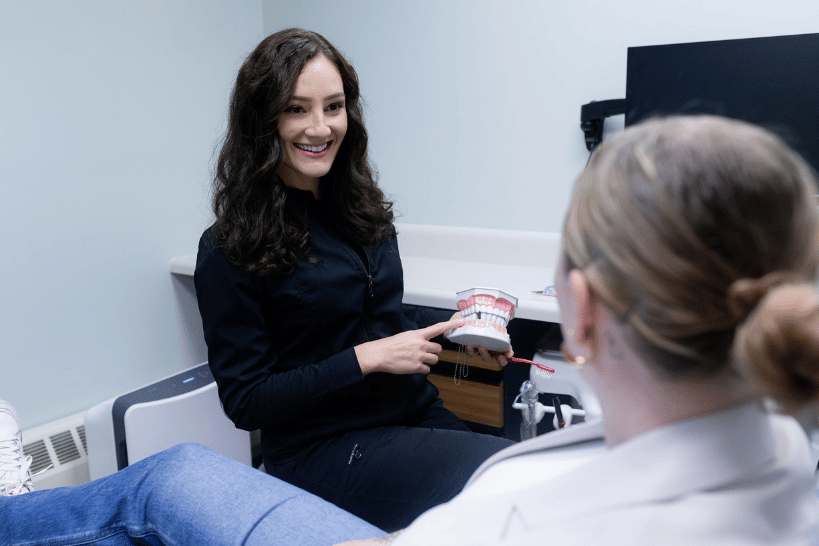You should brush your teeth twice a day, once in the morning and once before bed. This recommendation from the American Dental Association forms the foundation of effective oral health care and prevents most dental problems before they begin.

Why Twice Daily Brushing Works
Plaque accumulates on teeth continuously throughout the day and night. This sticky bacterial film feeds on food particles and sugars, producing acids that attack tooth enamel. Without regular removal, plaque hardens into tartar within 24-72 hours, which only professional dental cleaning can eliminate.
Morning brushing removes the overnight bacterial buildup and freshens breath for the day ahead. Evening brushing clears away the day’s accumulation of plaque and food debris, preventing bacteria from feeding on these materials overnight when saliva production decreases.
The Science Behind Timing
Tooth enamel undergoes a natural process called demineralization and remineralization throughout the day. After eating, the mouth pH drops below 5.5, creating an acidic environment that temporarily softens enamel. Saliva naturally neutralizes these acids over 30-60 minutes, allowing enamel to reharden.
Brushing immediately after eating acidic foods can actually brush away softened enamel. The optimal approach includes:
- Waiting 30-60 minutes after meals before brushing
- Rinsing with water immediately after eating to help neutralize acids
- Timing brushing sessions to maximize plaque removal without enamel damage
Choosing Effective Brushing Tools
Soft bristles provide optimal cleaning power while protecting delicate gum tissue and tooth enamel. Hard bristles can cause gum recession and enamel wear over time, creating more problems than they solve. Research consistently shows soft bristles remove plaque effectively without causing tissue damage.
Electric toothbrushes offer several advantages over manual versions. The consistent motion helps maintain proper brushing technique, and many models include timers ensuring adequate brushing duration. However, proper technique with a manual toothbrush achieves equally effective results.
Fluoride toothpaste strengthens tooth enamel through remineralization, reversing early stages of tooth decay. The American Dental Association seal ensures that the toothpaste contains effective fluoride levels and meets safety standards for daily use.

Proper Brushing Technique Maximizes Results
Two minutes of brushing allows enough time to clean all tooth surfaces thoroughly. Shorter brushing sessions leave plaque behind, while longer sessions don’t provide additional benefits and may cause unnecessary wear.
Gentle circular motions effectively disrupt plaque biofilm without damaging enamel or gums. Aggressive scrubbing creates microscopic scratches in tooth enamel that bacteria can colonize, actually increasing cavity risk over time.
The complete brushing routine includes all tooth surfaces: outer surfaces facing the cheeks, inner surfaces facing the tongue, and chewing surfaces. Brushing the tongue removes additional bacteria that contribute to bad breath and overall oral bacterial load.
The Critical Role of Flossing
Toothbrush bristles can’t reach the tight spaces between teeth where plaque accumulates and tooth decay often begins. Daily flossing removes plaque from these interdental spaces, preventing cavities that commonly form between teeth.
Flossing also removes plaque below the gumline, where gingivitis develops. This bacterial removal prevents gum inflammation that can progress to more serious periodontal disease affecting tooth-supporting structures.
When Additional Brushing Makes Sense
Certain medical conditions increase cavity risk, making more frequent brushing beneficial. Dry mouth from medications reduces saliva’s protective effects, allowing plaque to accumulate faster. Diabetes affects immune response, making thorough plaque removal even more critical for preventing infections.
People with braces or dental appliances trap more food particles and plaque, often requiring brushing after meals in addition to their twice-daily routine cleaning. The extra surfaces and crevices created by orthodontic hardware demand more thorough attention.
Long-term Benefits of Consistent Brushing
Regular twice-daily brushing prevents tooth decay by consistently removing the bacteria that produce cavity-causing acids. This simple habit eliminates the primary cause of dental problems, saving significant expense and discomfort over a lifetime.
Effective plaque removal also prevents gum disease, which affects nearly half of adults over 30. Gum disease connects to serious health conditions, including heart disease, diabetes complications, and stroke, making oral health maintenance crucial for overall wellness.

Professional Care Complements Home Routine
Even excellent home care cannot remove all plaque accumulation. Professional cleanings every six months eliminate hardened tartar and reach areas missed during daily brushing and flossing. Regular dental examinations detect problems early when treatment remains simple and affordable.
Dentist recommendations may vary based on individual risk factors. Some patients benefit from prescription fluoride toothpaste, antimicrobial mouth rinses, or more frequent professional cleanings based on their specific oral health needs.
Building Sustainable Habits
Consistency matters more than perfection. Missing occasional brushing sessions won’t cause immediate problems, but skipping regularly allows plaque accumulation that leads to tooth decay and gum disease.
Choose brushing times that fit naturally into daily routines. Many people find success brushing immediately after waking and before bed, creating automatic habits that require minimal willpower to maintain long-term.
Twice-daily brushing with fluoride toothpaste and soft bristles, combined with daily flossing, provides the foundation for lifelong oral health. This simple routine prevents most dental problems while supporting overall health and well-being.
